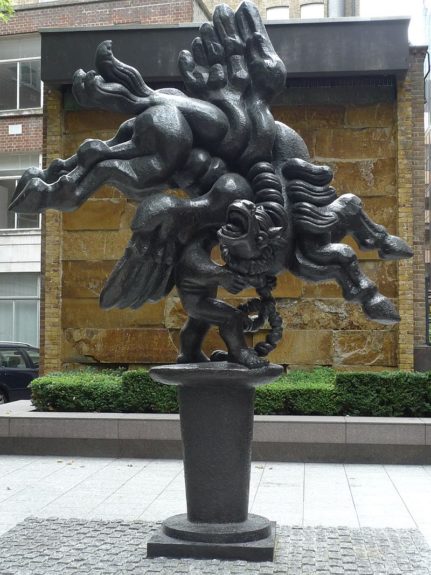Twenty-three tons of cast bronze, but infinite weight in the tons of confusion it causes. Just what the heck is it?
The statue outside of Columbia’s Law Library is one of the most misunderstood parts of campus. I’ve heard it described as “the big ugly statue on top of the law building entrance,” an indecipherable piece of metal, or even “me trying to teach criminal law” (an anonymous law professor). Undeniably, it is a blob. Personally, I think it looks really, really cool! And once you understand it, I think it becomes even cooler. Before I arrived for NSOP, I looked into the statue to understand the artwork—I’m studying art history, go figure—and to understand the feel of the campus.
Title: Bellerophon Taming Pegasus
Who:
Artist: Jacques Lipchitz. Lipchitz is a famous cubist sculptor of Lithuanian-Jewish descent. Born in Druskininkai in 1891, he studied art in Paris and was a contemporary of Picasso. During the German occupation of France, he fled to the United States and settled in Westchester county. Much of his work has a similar style to Bellerophon Taming Pegasus. Famously, when commissioned to make the sculpture he asserted “Don’t expect a blinded lady with scales and all those things from me…I will try to think of something else.” King.
Figures:
Bellerophon: Mythical Ancient Greek hero. Killed the Chimera. Considered one of the great monster slayers before Heracles. Grandson of Sisyphus. In the Corinthian royal family. Grandfather of Sarpedon and Glaucus. Following some messy dynamics in exile—he killed someone and was framed as a guest in exile—he eventually meets King Iobates sends him on a mission to kill the chimera that was terrorizing the countryside. To do so, he was told he would need Pegasus. After sleeping in the temple of Athena he is given a vision of a golden bridle which helps him tame the horse. Subsequently, he killed the chimera through its fire-breathing ability; after throwing a spear into the chimera’s throat, the hear melted the spear’s metal and suffocated it. His victory isn’t believed, so he is sent on many other trials. All of his success makes him cocky so he tries to fly to Olympus on Pegasus. Zeus intervenes and he falls to Earth, blinded and lives miserable until death.
Pegasus: Mythical horse with wings. Often depicted as an offspring of Medusa, born as she is beheaded by Perseus. Also portrayed as a descendent of Poseidon in later Greek mythology.

What:
The Image: Bellerophon ties a rope around the neck of a resisting Pegasus. It’s a chaotic and high-energy scene. Pegasus is in an intense frenzy. The image is more easily discernible in the form of a smaller bronze cast. The image to the left is an alternative cast of the statue in London with the features more discernable.
The Statue: An outdoor sculpture. Not the one pictured on the left. Twenty-tree tons. Thirty Feet by 28 feet. On a 27-foot pillar. Cast bronze. It’s one of the largest sculptures in NYC.
Where: Outside the law library! If you’ve ever made your way to the East campus, the SIPA building, Wien, faculty house, or really any other reason, you’ve absolutely seen it. It can even be seen menacingly looming on the horizon if you stand in Low plaza.
When: The statue was originally commissioned in 1964 for Columbia’s law school. However, it would take thirteen years before its dedication in 1977.
Why: While Law students have produced a cynical interpretation—to some, they feel like Pegasus as a force of nature now constricted by Law school, the law school and artist provide an alternative interpretation. A major theme of the sculpture is the taming of the wilds. The two figures–Bellerophon and Pegasus—are representative of humankind (Bellerophon) and nature (Pegasus). As the image portrays Bellerophon taming Pegasus, it is symbolic of humanity’s taming of the wild with the creation of laws. It is exceptionally fitting to adorn the entrance to a law school.
Law Library via Bwarchives
Bellerophon Taming Pegasus at the Broadgate Estate, London via Wikimedia Commons


 1 Comments
1 Comments
1 Comment
@Anonymous so informative